Is a single Pawn so very important?
Even a single Pawn can be the difference between winning and losing. This simple fact is vital for beginning chess players to understand. The material at your disposal is important — and that means every Pawn is important. Just winning a Pawn can be the edge that allows you to win; and losing a Pawn can be the edge that allows your opponent to win.
That little material advantage — a single Pawn — often comes down to the question of winning the King and Pawn vs. King ending.
Of course, knowing how to defend the ending can be the difference between a loss and a draw — but that will be the subject of a future blog post.
Use your King to fight!
The first simple rule to remember in most King and Pawn endings is this: get your King in front of your Pawn. If you do just that, you’ll win a lot more endgames. (And this rule applies to more than just King and Pawn endings.)
So the first rule is to get your King in front of your Pawn. A corollary to that rule is that you should not move your Pawn until your King is in front of your Pawn. Rather than impulsively pushing your Pawn as quickly as possible, you should advance your Pawn only when the way has been prepared by your King, driving the enemy King back to unfavorable positions.
The critical squares
In order to quickly decide whether you can win a King and Pawn ending, you should know that your Pawn has a critical square — in fact, it has three critical squares. The squares are called “critical” because you can win the game if your King can occupy one of those squares, while you will probably draw the game if you can’t. (Your opponent might blunder, of course; but analysis should never proceed on the hope or belief that your opponent will make a mistake.)
Note that these critical squares are only for the King and Pawn v. King endgame. There are different critical squares for different kinds of King and Pawn endgames.
The critical squares for all the Pawns except the Rook-pawns (i.e., Pawns on the b- through g-files) is the square that is two squares in front of the Pawn and the squares immediately adjacent to that square — unless the Pawn stands on the fifth rank, when the critical squares are moved back one row, directly in front of the Pawn. We’ll cover how to promote the Pawns on the c- through f-files in this article. The Knight-pawns (Pawns on the b- or g-files) and Rook-pawns (Pawns on the a- or h-files) have slightly different rules and procedures. We’ll cover those in a future blog post and video.
Here is a diagram showing the critical squares for a White Pawn on e2.
The d4, e4, and f4 squares are called “critical squares” because if White can occupy any one of them, he is guaranteed to win with best play. On the other hand, if Black can prevent White from occupying any of the critical squares, he is guaranteed a draw with best play. (Black need not occupy the critical squares — he need only prevent White from occupying the critical square in order to draw.)
The ending would proceed something like this.
- 1.Kd2 Ke7
- 2.Ke3 Kf7
Black realizes he can’t prevent White from getting his King to one of the critical squares, so he maneuvers to get the opposition.
- 3.Ke4 Ke6
Now White has occupied the critical square, but Black has the opposition. How does White make progress?
- 4.e3!
Now White has the opposition! Black must give way. (We should note that if it were White’s move in this position, Black would be able to draw the game. As it is, he must allow the White King to advance.)
It is also important to note that when the Pawn moved forward, the critical squares also moved forward. White must keep his King in front of the Pawn! His new objective: get the King to one of the new critical squares on d5, e5, or f5. Black moves:
- 4… Kd6
- 5.Kf5! Ke7
- 6.Ke5 Kd7
- 7.Kf6 Kd6
- 8.e4 Kd7
- 9.e5 Ke8
Now White has to “squeeze” Black off of the promotion square. This is a critical moment, and beginners can go wrong here. 10.e6?? would be a big mistake that throws away the win. Black would play 10…Kf8, and now 11.e7+ Ke8 and now White must choose between 12.Ke6 stalemate and moving the King away so that Black can capture the Pawn. Remember the rule: King in front!
- 10.Ke6 Kd8
- 11.Kf7
From this square, the King protects all the squares leading to the promotion square. The Pawn just marches in.
- 11… Kd7
- 12.e6+ Kd8
- 13.e7+ Kd7
- 14.e8(Q)+ …
And White wins.
In the next installment, we’ll see how to defend this position — how to draw with a King against a King and Pawn.

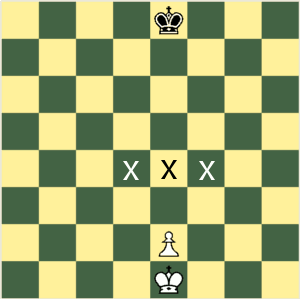
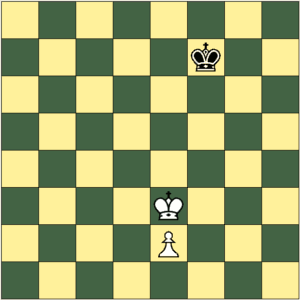
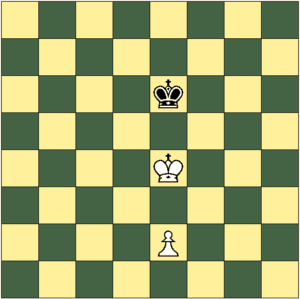
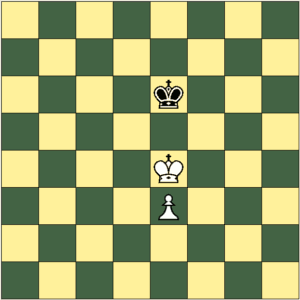
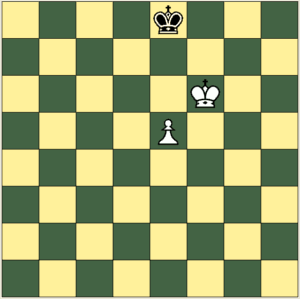
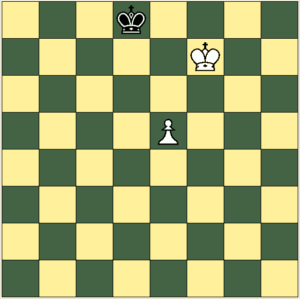

you stupid, confused critical with key squares???
Well, maybe I am stupid; but I wasn’t confused. If you prefer to call them “key squares,” please go ahead. It’s the concept that matters, not the name you use for the concept.
It is true that Dvoretsky employs the term “key squares” in his seminal text, but the term critical squares was employed in the initial development of the topic. See F. Dedrle article in Deutsches Wochenbuch (1921) where he employs the term “kritischen Felder” (critical fields, or squares). A publication that I’ve recently run across mentions another article by Dedrle from 1919 that discusses Jan Drtina’s development of the concept of critical squares. Alas, I do not have a citation. In any case, the term “key squares” is likely a simplified translation of a term more precisely translated as critical squares.
Thanks for sharing your research, James. Excellent!!